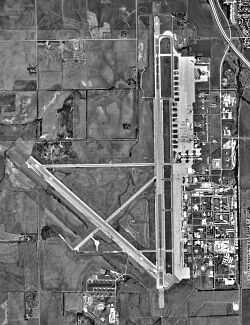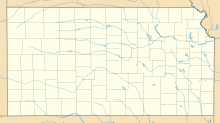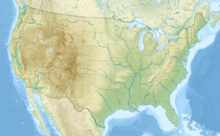Salina Regional Airport facts for kids
Quick facts for kids
Salina Regional Airport
|
|||||||||||||||||||||||
|---|---|---|---|---|---|---|---|---|---|---|---|---|---|---|---|---|---|---|---|---|---|---|---|
 |
|||||||||||||||||||||||

USGS 1991 orthophoto
|
|||||||||||||||||||||||
| Summary | |||||||||||||||||||||||
| Airport type | Public | ||||||||||||||||||||||
| Owner | Salina Airport Authority | ||||||||||||||||||||||
| Serves | Salina, Kansas | ||||||||||||||||||||||
| Elevation AMSL | 1,288 ft / 393 m | ||||||||||||||||||||||
| Coordinates | 38°47′26″N 097°39′08″W / 38.79056°N 97.65222°W | ||||||||||||||||||||||
| Map | |||||||||||||||||||||||
| Runway | |||||||||||||||||||||||
|
|||||||||||||||||||||||
| Statistics (2023) | |||||||||||||||||||||||
|
|||||||||||||||||||||||
|
Source: Federal Aviation Administration
|
|||||||||||||||||||||||
Salina Regional Airport (IATA: SLN, ICAO: KSLN, FAA LID: SLN) is an airport in Salina, Kansas, United States. It used to be called Salina Municipal Airport. The Salina Airport Authority owns and runs it. This airport is mainly used for general aviation, which means private planes and business jets. It also has flights from one passenger airline, SkyWest Airlines, which flies as United Express. This airline gets help from a program called Essential Air Service to make sure smaller towns have flights.
The airport is also home to K-State Salina. This campus has a special aviation department. Students there can study to become professional pilots. They can also get other degrees related to aviation.
This airport is built on the land that used to be a military base. It was first called Smoky Hill Army Airfield. Later, it became Smoky Hill Air Force Base, and then Schilling Air Force Base.
Contents
Airport History
Building a Military Airfield
After the attack on Pearl Harbor in 1941, the United States joined World War II. The country needed more military airfields. So, they built the Smoky Hill Army Airfield (AAF) on 2,600 acres southwest of Salina, Kansas.
Construction started in May 1942. Nearly 7,000 workers helped build the base. The airfield officially opened on September 1, 1942. It was part of the Second Air Force.
Training for War
By September 10, 1942, enough buildings were ready for the first military unit to move in. The first planes, Boeing B-17 Flying Fortress bombers, arrived later that month.
The main job of Smoky Hill AAF was to train heavy bomber crews. This was the second step of their training. Combat groups practiced working together as a team. They learned about bombing, gunnery, and flying using instruments. After this, they would go to the final training step before flying overseas for combat.
In April 1943, the 49th Aviation Squadron arrived. This unit was made up of all African American mechanics, electricians, and aircraft handlers. They helped keep the planes ready.
Changes After the War
After World War II, the military changed. On March 21, 1946, the airfield became part of the Strategic Air Command. Then, in January 1948, after the Air Force was formed, the airfield was renamed Smoky Hill Air Force Base.
As the government spent less money on the military, the base closed in late 1949.
Reopening and a New Name
The base reopened on August 1, 1951, because of the Korean War. It hosted two bomber wings, the 310th and 40th.
On March 16, 1957, the base was renamed Schilling Air Force Base. This was to honor Colonel David C. Schilling.
Base Closure
In 1964, people started hearing that the base might close. In November, the Secretary of Defense announced that Schilling AFB would be one of many military bases to shut down. The closing process started in 1965 and finished in 1967.
Record-Breaking Flights
Salina Regional Airport became famous for two amazing flights. The Virgin Atlantic GlobalFlyer aircraft took off and landed here. It was flown by Steve Fossett.
From February 28 to March 3, 2005, Steve Fossett made the first nonstop, non-refueled solo flight around the Earth. He flew the GlobalFlyer all by himself without stopping or getting more fuel.
In 2006, he flew the GlobalFlyer again from Salina. This time, he broke the world record for distance over a closed circuit without landing. This means he flew a very long distance in a circle without touching down.
The airport has a special place called Fossett Plaza to remember these records. It has a memorial, places to sit, and plaques that tell the story of the GlobalFlyer and Steve Fossett. You can also watch planes from there.
Airlines Over the Years
Salina first had regular airline service in the early 1930s. United States Airways flew airmail planes that stopped in Salina. This service ended around 1933.
Airline service returned in 1949 with Continental Airlines. They used Douglas DC-3 planes. They flew between Denver and Kansas City, stopping at many smaller cities. Continental stopped its service in 1961.
Central Airlines took over in 1961, also using DC-3s. They later used newer planes like the Convair 240 and Convair 600. In 1967, Central joined Frontier Airlines. Frontier used Convair 580s. In 1978, Frontier even brought Boeing 737 jets to Salina. All Frontier service ended in 1983.
Air Midwest also served Salina at different times. They started in the late 1960s with small planes. They later flew to Kansas City and Wichita. From 1986, Air Midwest worked with bigger airlines like Eastern Express and USAir Express. They flew smaller planes to connect passengers to larger flights. All Air Midwest service ended in 2008.
Other airlines like Capitol Air Service, Great Lakes Airlines, and SeaPort Airlines also flew from Salina over the years. They used different types of planes, from small Twin Otters to regional jets.
Today, SkyWest Airlines flies from Salina as United Express. They use Bombardier CRJ100/200 regional jets. They offer daily flights to Chicago–O'Hare and Denver.
Airport Features
Runways and Operations
The airport covers a large area of 2,862 acres (1,158 hectares). It is 1,288 feet (393 meters) above sea level. It has four runways, which are like long, paved roads for planes to take off and land. The longest runway is 12,301 feet (3,749 meters) long.
In the year ending March 31, 2023, the airport had 70,884 aircraft operations. This means about 194 planes took off or landed each day.
"America's Fuel Stop"
Salina Regional Airport has a very long runway. It is also located close to the center of the United States. Because of this, many corporate and private jets stop here to refuel. Passengers can also take a break. This has given Salina the nickname "America's Fuel Stop." A company called Avflight Salina handles all the fueling and ground services for these planes.
The airport is also used for many special activities. These include missions by NASA (the space agency), NOAA (which studies weather and oceans), and groups like Wings of Freedom.
Where You Can Fly From Salina
Passenger Flights
| Airlines | Destinations |
|---|---|
| United Express | Chicago–O'Hare, Denver, Hays |
| Destinations map |
|---|
Keeping the Area Safe and Clean
Years ago, when the airport was a military base, certain liquids were used to clean aircraft. These liquids sometimes seeped into the ground. A report from 1953 mentioned that a lot of cleaning solvent was used.
Later, in 1989, it was discovered that some of these cleaning chemicals had spread into the soil and underground water. This created an area where the water was not safe to drink. The Kansas Department of Health and Environment advised people in the affected area not to drink the water.
Since then, different groups have been working together to study and clean up the area. These groups include the US Army Corps of Engineers, the city of Salina, the Salina Airport Authority, and Kansas State University. They are making sure the soil and water are safe. Studies are still ongoing to monitor the situation and ensure the cleanup is effective.
Images for kids
-
USGS 1991 orthophoto




